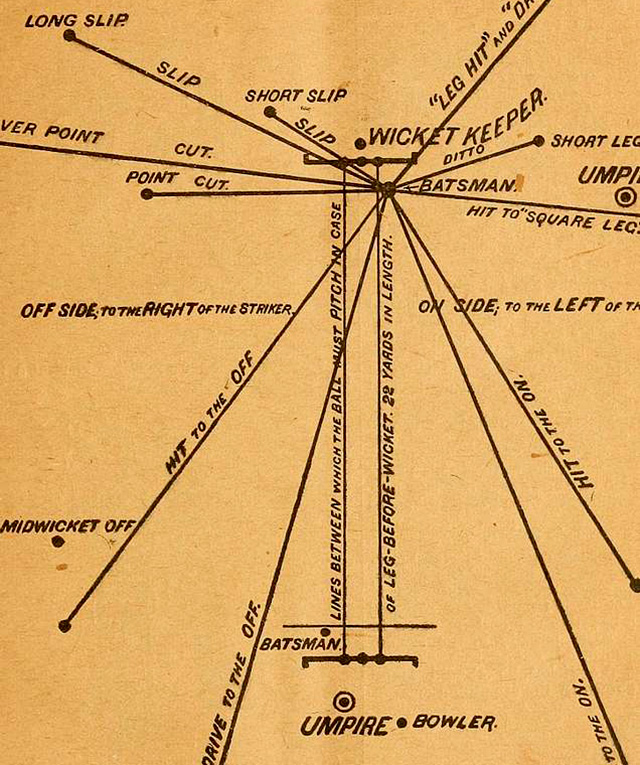Cricket is a bat-and-ball game played between two teams of eleven players each. The game is played on a circular or oval-shaped field with a rectangular 22-yard-long pitch in the center. The objective of the game is to score more runs than the opposing team.
 from "The reliable book of outdoor games" 1893
from "The reliable book of outdoor games" 1893 Here are some basic rules of cricket. There are many other intricacies to the game that can vary based on the format of the game and the level of play.
- Players: Each team has eleven players, including a captain, and they take turns playing offense (batting) and defense (fielding).
- Innings: In cricket, each team takes turns batting and fielding. A full game (test match) consists of two innings per team, with the exception of some shorter formats of the game such as ODIs and T20s. (see types of cricket)
- Equipment: The equipment used in cricket includes a bat, a ball, and wickets. The bat is flat on one side and can be no more than 38 inches in length. The ball is typically made of cork, covered in leather, and weighs between 5.5 and 5.75 ounces. Wickets are made of three wooden stumps and two bails.
- Scoring: The basic way to score runs is by hitting the ball and running to the opposite end of the pitch. If the ball is hit to the boundary, a four or six runs are awarded depending on whether it bounces before crossing the boundary or not. The team with the highest score at the end of the game wins.
- Bowling: The bowling team takes turns bowling the ball to the batsmen, and the objective is to hit the wickets or get the batsmen out in another way (see ways of getting out). The bowler must not throw the ball but instead bowl it overhand with a straight arm.
- Batting: The batting team tries to score runs while protecting their wickets. Each batsman takes turns facing the bowler, and the objective is to hit the ball and score runs. A batsman is out if they hit the ball in the air and it is caught by a fielder, or if the ball hits the wicket and the bails are dislodged (there are other less common ways of getting out too).
- Extras: If a no-ball or a wide ball is bowled, the batting team is awarded an extra run (but the score is not credited to the batsman). Other extras are byes and leg byes, and penalty runs.
- Fielding: The fielding team tries to take wickets and prevent the batting team from scoring runs. Fielders can catch the ball or stop it and throw it to the wickets to get a run-out.
Related Pages
- What is Cricket? a brief summary
- How to get out in cricket
- List of Cricketing Terms
- Versions of cricket games
- Other Sports Rules


 Upcoming Events
Upcoming Events